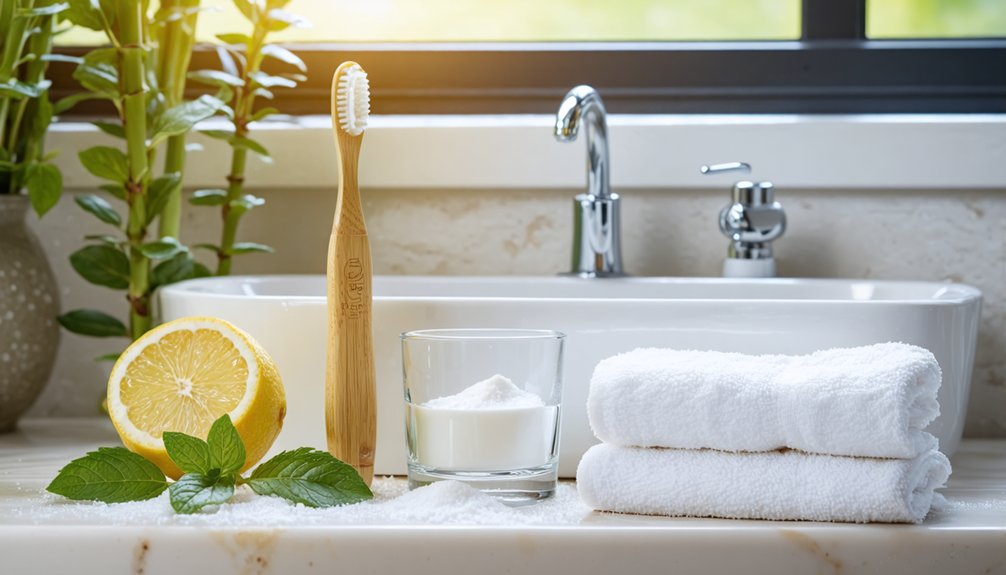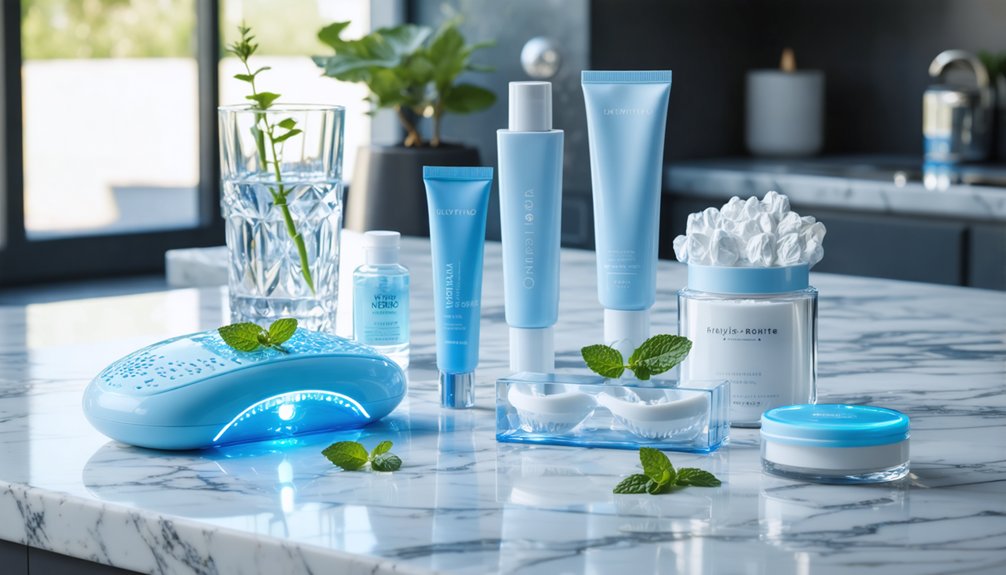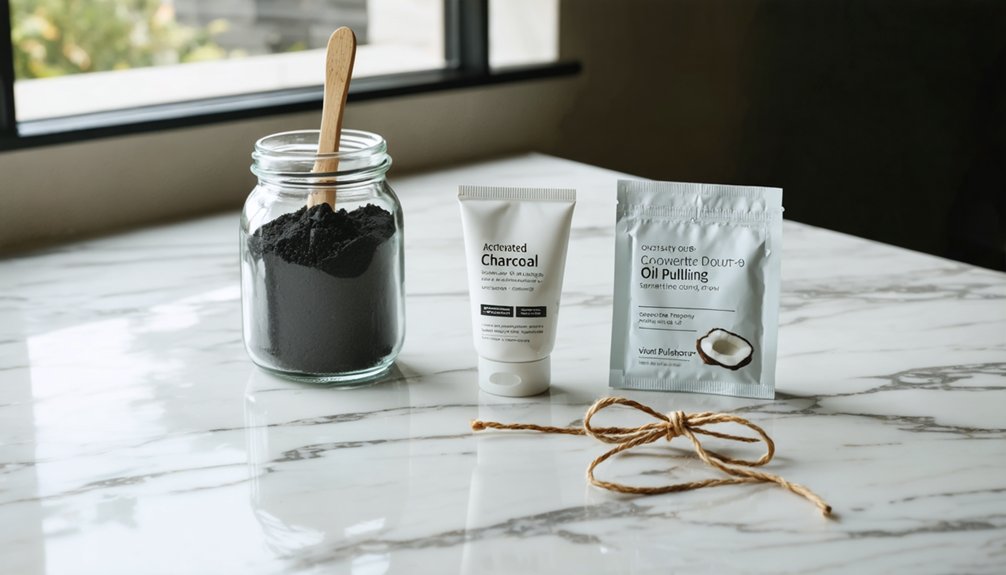If you have sensitive teeth, start with professional consultation to assess your enamel health before whitening. Choose products specifically formulated for sensitivity, containing lower peroxide concentrations (5.25% or less), and limit treatment sessions to 10-30 minutes. Apply desensitizing agents before and after treatments, alternate days for recovery, and immediately stop if persistent sensitivity occurs. For ideal results, combine gentle whitening with protective measures like fluoride rinses and proper timing between sessions.
Key Takeaways
- Start with low-concentration peroxide products (5.25% or less) and limit treatment sessions to 20-30 minutes initially.
- Choose professional custom-fitted trays to prevent gel leakage and minimize gum irritation during whitening treatments.
- Alternate whitening days to allow recovery time and use desensitizing agents containing potassium nitrate between treatments.
- Consider professional in-office treatments with calcium phosphate treatments and temperature regulation for enhanced comfort and safety.
- Stop treatment immediately if sensitivity persists beyond 48 hours and consult a dentist for personalized guidance.
Understanding Tooth Sensitivity Before Whitening
Before pursuing any teeth whitening treatment, it’s vital to understand that tooth sensitivity affects a significant portion of the population, with up to 74% experiencing some degree of dental sensitivity.
Research shows that sensitivity affects people of all age ranges, with cases peaking between 38-47 years old.
If you’re already experiencing sensitivity to hot, cold, or sweet stimuli, you’ll need to address these issues before considering whitening procedures.
Understanding tooth anatomy and sensitivity mechanisms is fundamental for successful treatment. Your teeth’s protective enamel can become compromised through erosion, decay, or wear, exposing the underlying dentinal tubules. Winter weather can intensify sensitivity issues when breathing cold air triggers tooth pain.
This exposure typically causes sharp, sudden pain when triggered. Since sensitivity often indicates underlying dental conditions like cavities or gum recession, you’ll want to have a professional evaluation first.
Remember that untreated sensitivity can worsen and impact your daily activities, from eating to maintaining proper oral hygiene.
Professional Whitening Options for Sensitive Teeth
Professional in-office teeth whitening offers you advanced treatments with carefully controlled conditions and immediate oversight from your dentist.
Treatment plans often begin with calcium phosphate treatments to strengthen enamel before whitening begins.
You’ll benefit from customized treatment plans that can incorporate desensitizing agents, temperature regulation, and buffering compounds to minimize discomfort.
Custom-fitted trays guarantee precise application of whitening agents while protecting your sensitive gum tissue from exposure to harsh chemicals. These treatments deliver fast dramatic results while maintaining comfort through professional monitoring.
In-Office Treatment Benefits
When considering teeth whitening with sensitive teeth, in-office treatments provide significant advantages over at-home alternatives. Your dentist will perform a thorough assessment of your oral health and sensitivity levels before customizing whitening techniques specifically for you.
They’ll adjust peroxide concentrations and exposure times to maximize patient comfort while achieving peak results. Special numbing medication is available to help ensure a more comfortable whitening experience. Since sensitivity often comes from exposed tooth surfaces, dentists can take extra precautions in those areas.
Professional treatments utilize advanced systems like Philips Zoom!® with specialized lights and lower-peroxide gels, alongside desensitizing agents that protect your teeth.
You’ll benefit from real-time monitoring, allowing immediate adjustments if sensitivity occurs. Custom-fitted trays guarantee even gel application, preventing chemical burns and gum irritation.
Additionally, you’ll receive pre-treatment professional cleaning to remove surface stains and plaque, making the whitening process more effective and comfortable.
Custom Tray Safety Measures
To guarantee ideal safety during teeth whitening, custom-fitted trays provide essential protection for patients with sensitive teeth. These precisely crafted trays guarantee optimal gel distribution while minimizing gum contact, greatly reducing the risk of irritation. Using carbamide peroxide gel provides effective whitening while being gentler on sensitive teeth.
Your dentist can adjust the trays to accommodate areas of gum recession and select appropriate gel concentrations for your sensitivity level. One hour wear per evening for two weeks is typically sufficient for optimal results.
Key custom tray benefits include:
- Snug fit prevents gel leakage and keeps whitening agent focused only on targeted teeth
- Precise gel application allows for controlled treatment with minimal product waste
- Built-in reservoirs protect sensitive gum tissue while maximizing whitening effectiveness
Before gel application, you’ll need clean, dry trays and freshly brushed teeth.
Apply small amounts of gel to the front surface of each tooth chamber, avoiding overfilling to prevent gum contact and discomfort.
Safe At-Home Whitening Methods
For best results with at-home teeth whitening, you’ll want to select products specifically formulated for sensitive teeth, such as lower-concentration peroxide gels and gentle whitening strips.
When using custom-fitted trays, you should limit wear time to 10-30 minutes and consider alternating days of treatment to minimize sensitivity. Professional take-home systems can be 84% stronger than over-the-counter options while still maintaining comfort. Consulting with a dental professional first helps evaluate your overall dental health and suitability for whitening treatments.
You can achieve effective whitening through a gradual approach that combines sensitivity-focused products with proper usage techniques, including pre-treatment with desensitizing toothpaste and careful monitoring of your comfort level.
Choosing Low-Sensitivity Products
People with sensitive teeth can still achieve a brighter smile by choosing specially formulated whitening products with lower concentrations of active ingredients.
Look for products containing gentle whitening ingredients like phthalimidoperoxycaproic acid (PAP) or low peroxide options specifically designed for sensitivity. These formulations often include desensitizing compounds like potassium nitrate or strontium chloride to minimize discomfort.
- Select whitening strips or pens labeled for sensitive teeth, which use lower peroxide concentrations for gradual brightening.
- Consider peroxide-free alternatives containing natural compounds like coconut oil or sage extract.
- Choose products with built-in desensitizing agents that actively protect your teeth during the whitening process.
Remember to start with the mildest formulation available and gradually increase usage as your teeth adapt to the treatment.
Custom Tray Whitening Tips
While over-the-counter whitening products can cause discomfort, custom-fitted whitening trays offer a safer and more controlled approach for patients with sensitive teeth. These trays are molded precisely to your teeth, ensuring even gel distribution and minimal leakage onto gums.
For best results with custom trays, keep gel application time to 15-30 minutes per session, as the whitening agent loses effectiveness after 15 minutes. Wipe away any excess gel that contacts your gums immediately using a Q-tip.
You’ll achieve better outcomes through consistent, short-duration sessions rather than extended wear periods. If sensitivity develops, you can pause treatment or switch to lower-concentration gels in the same trays.
Your dentist can adjust the gel strength based on your comfort level while maintaining effectiveness.
Gradual Whitening Approach
Beyond custom trays, a gradual at-home whitening approach offers sensitive patients a controlled path to brighter teeth. This gentle technique focuses on using low-concentration peroxide products specifically designed for sensitive teeth, combined with strategic timing and application methods.
- Start with whitening strips or pens containing 5.25% peroxide or less, applying them for shorter durations than recommended – typically 20-30 minutes.
- Allow recovery days between treatments and extend your whitening period over several weeks for more comfortable, gradual results.
- Support your whitening journey with desensitizing pre-treatments and protective post-care, including fluoride rinses and sensitivity toothpaste.
This measured approach prioritizes enamel safety while still achieving noticeable whitening results. You’ll experience less discomfort while helping patients maintain their oral health throughout the process.
Natural Alternatives for Gentle Whitening
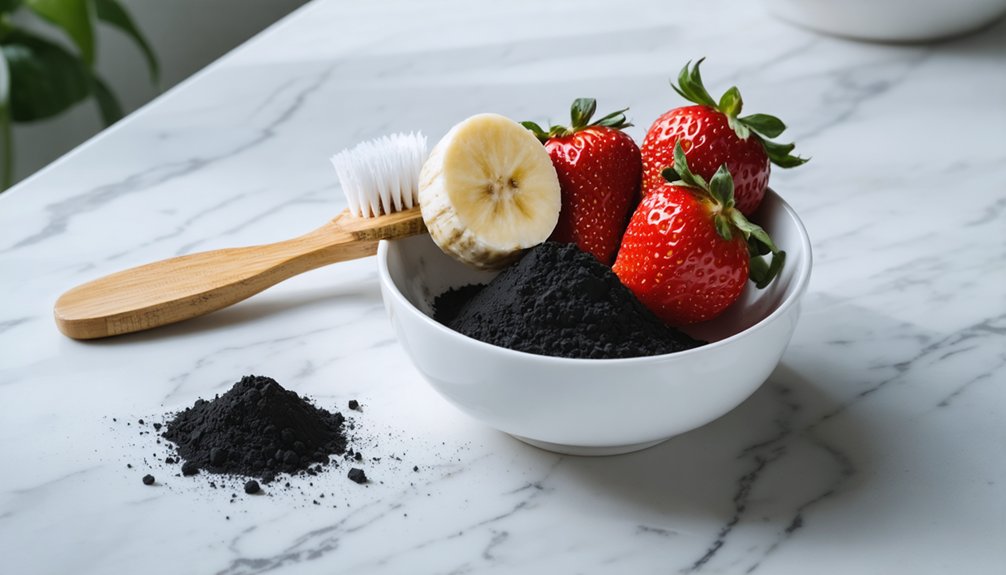
For sensitive teeth patients seeking gentler whitening solutions, natural alternatives offer less aggressive approaches compared to traditional bleaching methods.
Oil pulling with coconut oil has shown promise in reducing oral bacteria and surface stains without damaging enamel. You’ll want to swish the oil for 15-20 minutes daily for gradual results.
Strategic dietary adjustments can support your whitening goals. While crunchy fruits and vegetables won’t directly whiten teeth, they help clean tooth surfaces mechanically.
Chewing sugar-free gum after meals increases saliva production, which naturally cleanses teeth. You’ll also benefit from avoiding stain-causing beverages like coffee and red wine.
When combined with gentle brushing using a soft-bristled toothbrush and non-abrasive fluoride toothpaste, these natural approaches provide a safe path to maintaining whiter teeth without aggravating sensitivity.
Protective Diet and Lifestyle Changes
Making strategic dietary and lifestyle adjustments can considerably reduce tooth sensitivity after whitening treatments.
You’ll need to focus on protective foods while avoiding temperature extremes and staining agents. Choose lukewarm, calcium-rich options like yogurt and cheese to strengthen your enamel, and stick to gentle proteins such as chicken and white fish.
- Avoid hot or cold foods and beverages for the first 48 hours, opting instead for room temperature items to minimize nerve irritation.
- Eliminate acidic and staining foods including coffee, wine, citrus fruits, and dark-colored sauces.
- Practice sensitivity management through gentle brushing techniques with a soft-bristled toothbrush, and use fluoridated toothpaste specifically formulated for sensitive teeth.
Managing Post-Treatment Sensitivity
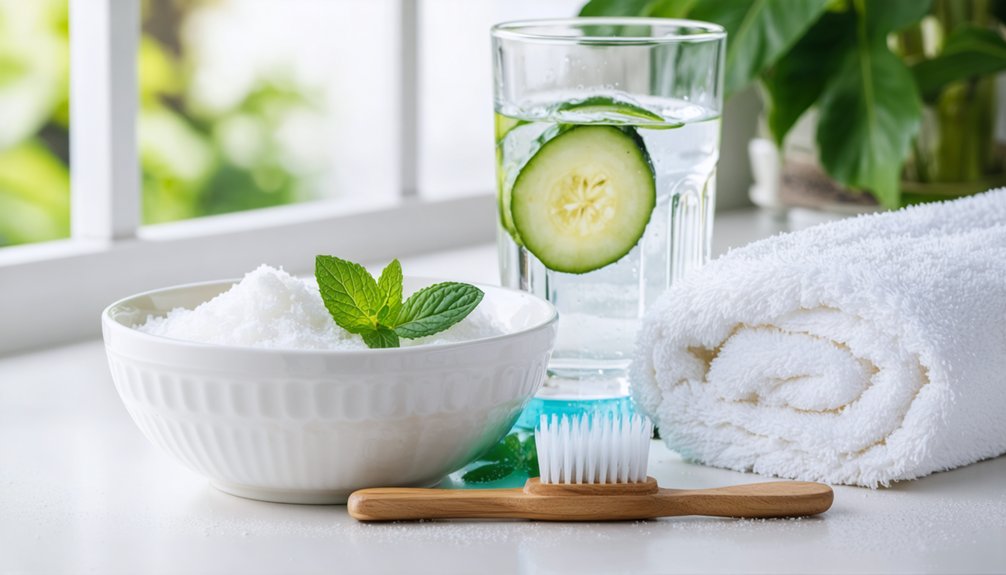
While tooth sensitivity after whitening treatments is common, several effective strategies can help manage discomfort.
Apply desensitizing agents containing potassium nitrate and sodium fluoride before and after treatment to block nerve pain signals and seal exposed dentin. You’ll find relief by avoiding hot and cold foods for several days and rinsing with warm salt water to soothe irritated tissues.
Combat tooth sensitivity with specialized desensitizing agents and avoid temperature extremes while letting salt water rinses soothe tender areas.
For immediate post-treatment remedies, try chewing sugarless gum to reduce residual peroxide levels, and use over-the-counter pain relievers if needed.
Continue using gentle oral care products, avoiding abrasive toothpastes that could worsen sensitivity. If you experience discomfort lasting longer than four days or develop unusual pain, contact your dental professional immediately for assessment and additional management options.
Signs to Stop Whitening Treatment
To guarantee safe teeth whitening, you need to recognize critical warning signs that warrant immediate treatment cessation. Proper symptom identification helps prevent potential damage to your teeth and gums.
When you notice persistent sensitivity lasting more than two days, chemical burns on soft tissues, or unusual discomfort, stop treatment immediately and consult your dentist.
- Intense tooth sensitivity or electric shock-like sensations that don’t subside within 48 hours
- Development of gum irritation, swelling, or persistent burning sensation
- Throat or stomach discomfort from accidental ingestion of whitening agents
If you’re taking medications or have pre-existing dental conditions, monitor your response carefully during treatment.
Stop whitening if you experience adverse reactions or if your oral health deteriorates during the process.
Best Products for Sensitive Teeth
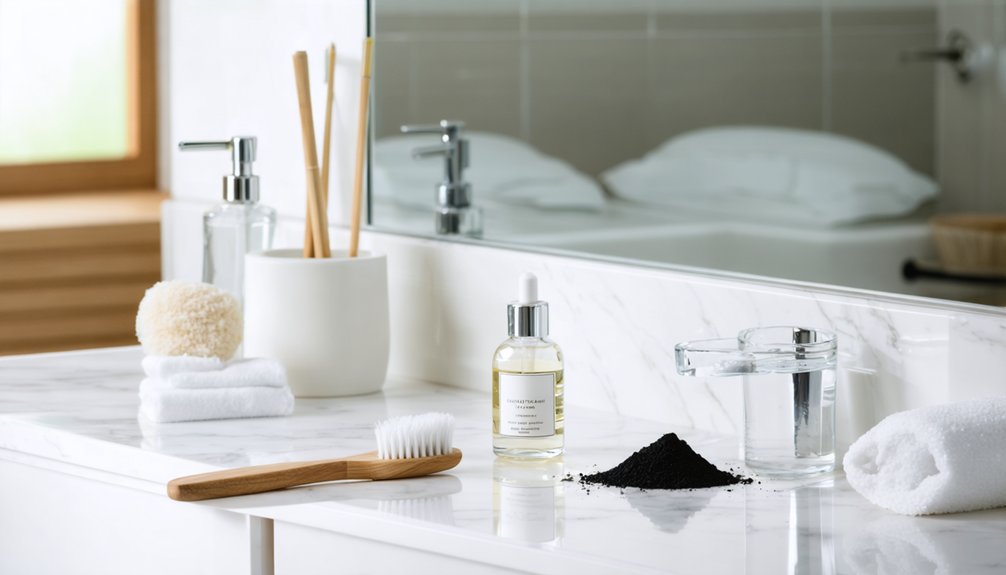
For patients with sensitive teeth, selecting the right whitening products can mean the difference between successful brightening and painful setbacks.
You’ll find several effective options specifically designed to minimize sensitivity triggers while achieving noticeable results.
Low-peroxide products like Crest 3D White Whitestrips Gentle Routine and Snow Whitening Kit offer controlled whitening with reduced irritation.
Look for products containing desensitizing agents such as potassium nitrate and fluoride, which help block nerve pain and strengthen enamel during treatment.
The Crest 3D Whitestrips Sensitive + LED Light system requires just 30 minutes of daily use, limiting peroxide exposure.
For a gentler approach, consider natural alternatives like Oral Essentials Lumineux, which uses plant-based ingredients, or professional options like Zoom Whitening that allow dentist-supervised treatment with customized peroxide concentrations.
Long-Term Maintenance Strategies
Maintaining whitening results while managing tooth sensitivity requires a thorough, long-term approach that extends beyond initial treatments.
You’ll need to focus on enamel preservation through consistent oral hygiene and strategic dietary choices. Combine regular dental visits with at-home care to protect your investment in a brighter smile.
- Practice strict oral hygiene using fluoride toothpaste and soft-bristled brushes twice daily, supplemented with daily flossing to prevent sensitivity-triggering plaque buildup.
- Schedule professional fluoride treatments every 3-6 months while spacing out whitening sessions to allow proper enamel recovery time.
- Adopt a tooth-friendly diet rich in calcium, limiting acidic foods and extreme temperature beverages that can compromise long-term enamel strength.
Your commitment to these maintenance strategies will help preserve both whitening results and dental health over time.
Frequently Asked Questions
How Long Should I Wait Between Professional Whitening Treatments?
Tick tock, let time be your guide: you’ll need to wait 6-12 months between professional whitening treatments. This ideal whitening frequency protects your enamel while maintaining treatment duration effectiveness.
Can Pregnancy or Breastfeeding Affect My Teeth Whitening Options?
Due to pregnancy precautions, you’ll need to postpone whitening until after delivery. While breastfeeding safety concerns are minimal, always consult your dentist and doctor before starting any whitening treatment.
Does Teeth Whitening Work on Dental Crowns or Veneers?
Like trying to bleach a ceramic tile, crowns whitening won’t change your restoration’s color. Your veneers discoloration can’t be lifted because these materials lack natural teeth’s porous structure to absorb whitening agents.
Are Certain Medications Known to Interfere With Teeth Whitening Treatments?
Yes, your medications can affect whitening safety and results. Antibiotics, antihistamines, and blood pressure drugs may cause resistant stains or increase sensitivity during treatment. Always discuss medication interactions with your dentist.
Can Whitening Treatments Affect Existing Dental Bonding or Fillings?
You won’t be able to whiten your bonding or fillings – they’ll stay the same color while your natural teeth brighten. This can lead to bonding discoloration mismatches and potential filling sensitivity.
References
- https://www.dentistatplumcreek.com/blog/whiten-sensitive-teeth-naturally/
- https://www.goodmandentalcenter.com/blog/i-have-sensitive-teeth-can-i-still-get-teeth-whitening-treatment
- https://www.sensodyne.com/en-us/oral-health-tips/whitening-sensitive-teeth/what-to-know/
- http://www.goochlanddentistry.com/whats-the-best-teeth-whitener-for-sensitive-teeth/
- https://www.goodrx.com/conditions/dental-care/is-teeth-whitening-safe
- https://www.colgate.com/en-in/oral-health/teeth-whitening/how-to-get-rid-of-teeth-sensitivity-after-whitening
- https://www.drbobsdentalcare.com/is-teeth-whitening-safe-for-sensitive-teeth/
- https://pmc.ncbi.nlm.nih.gov/articles/PMC7448347/
- https://pmc.ncbi.nlm.nih.gov/articles/PMC11326452/
- https://www.haleon.com/news/press-releases/brand/2023/new-study-reveals-now-1-in-2-adults-are-sufferung-the-pain-of-tooth-sensitivity
